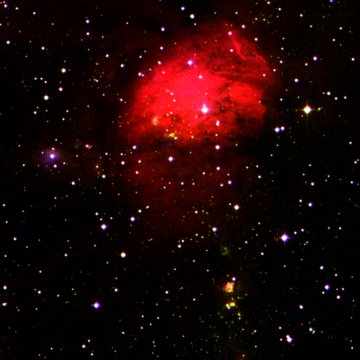Sh 2-235
Coordinates: (173.61°, 2.8°)
[ Catalog | Explorer | SIMBAD ]
One of these molecular clouds, G174+2.5, contains Sh 2-231, Sh 2-232, Sh 2-233, and Sh 2-235 and lies at a distance of about 1800 pc.
Sh 2-235 is ionised by the O9.5 V star BD +35 1201. Avedisova places this nebula in star formation region SFR 173.61+2.80 with 54 components, including 7 masers, the smaller HI region BFS 46 and several Herbig-Haro objects.
Sh 2-231 to Sh 2-235 form a complex of HII regions located together in the Perseus arm in the outer galaxy. This complex may be associated with an old (330 thousand years) supernova remnant, FVW 172.8+1.5.
You can view a larger visual frequency image of Sh 2-235 here and an infrared image here.
This apparently tiny HII region is in fact the intersection point of two massive giant molecular clouds (100 thousand and 300 thousand solar masses respectively) with intensive star formation occurring. It is excited by the O9.5 V star BD+35 1201. [2]
Sh 2-231 to Sh 2-235 form a complex of HII regions located together in the Perseus arm in the outer galaxy. This complex may be associated with an old (330 thousand years) supernova remnant, FVW 172.8+1.5. [3]
There is a giant molecular cloud containing Sh 2-231, Sh 2-232, Sh 2-233, and Sh 2-235 that is at a distance of about 1800 pc.[4]
Notes
1. ^ Dewangan, L. K. & Anandarao, B. G. (2011). "Infrared photometric study of the massive star-forming region S235 using Spitzer-Infrared Array Camera and JHK observations", Monthly Notices of the Royal Astronomical Society, Vol. 414, 1526-1544. [2011MNRAS.414.1526D]
2. ^ Lafon, G., Baudry, A., de La Noe, J., et al. (1983). "The molecular cloud-H II region complexes associated with SH 90 and SH 235", Astronomy and Astrophysics, Vol. 124, 1-10. [1983A&A...124....1L]
3. ^ Kang, Ji-hyun, Koo, Bon-Chul, & Salter, Chris (2012). "An Old Supernova Remnant within an H II Complex at l ≈ 173°: FVW 172.8+1.5", The Astronomical Journal, Vol. 143, 75. [2012AJ....143...75K]
4. ^ Shepherd, D. S. & Watson, A. M. (2002). "A Detailed Study of G173.58+2.45: an Intermediate-Mass Star-forming Region", The Astrophysical Journal, Vol. 566, 966-973. [2002ApJ...566..966S]
Distance estimates
1800 pc [1996ApJ...463..630H]Links
[ DSS | ADS | ADS Abstract ]
map | book | blog | gallery | sources

This image was created using the POSS-II/UKSTU data of the Digitized Sky Survey and SuperCOSMOS using the process described here.
According to my correspondence with the Royal Observatory Edinburgh and the Space Telescope Science Institute, I am allowed to use the POSS-II/UKSTU data to create and display images for non-commercial purposes so long as I include this fine print for the SuperCOSMOS data:
Use of these images is courtesy of the UK Schmidt Telescope (copyright in which is owned by the Particle Physics and Astronomy Research Council of the UK and the Anglo-Australian Telescope Board) and the Southern Sky Survey as created by the SuperCOSMOS measuring machine and are reproduced here with permission from the Royal Observatory Edinburgh.
and this acknowledgement taken from the DSS site:
The Digitized Sky Surveys were produced at the Space Telescope Science Institute under U.S. Government grant NAG W-2166. The images of these surveys are based on photographic data obtained using the Oschin Schmidt Telescope on Palomar Mountain and the UK Schmidt Telescope. The plates were processed into the present compressed digital form with the permission of these institutions.
The Second Palomar Observatory Sky Survey (POSS-II) was made by the California Institute of Technology with funds from the National Science Foundation, the National Geographic Society, the Sloan Foundation, the Samuel Oschin Foundation, and the Eastman Kodak Corporation.
The UK Schmidt Telescope was operated by the Royal Observatory Edinburgh, with funding from the UK Science and Engineering Research Council (later the UK Particle Physics and Astronomy Research Council), until 1988 June, and thereafter by the Anglo-Australian Observatory. The blue plates of the southern Sky Atlas and its Equatorial Extension (together known as the SERC-J), as well as the Equatorial Red (ER), and the Second Epoch [red] Survey (SES) were all taken with the UK Schmidt.
The "Second Epoch Survey" of the southern sky was made by the Anglo-Australian Observatory (AAO) with the UK Schmidt Telescope. Plates from this survey have been digitized and compressed by the ST ScI. The digitized images are copyright ? 1993-5 by the Anglo-Australian Observatory Board, and are distributed herein by agreement.
The "Equatorial Red Atlas" of the southern sky was made with the UK Schmidt Telescope. Plates from this survey have been digitized and compressed by the ST ScI. The digitized images are copyright ? 1992-5, jointly by the UK SERC/PPARC (Particle Physics and Astronomy Research Council, formerly Science and Engineering Research Council) and the Anglo-Australian Telescope Board, and are distributed herein by agreement.
The compressed files of the "Palomar Observatory - Space Telescope Science Institute Digital Sky Survey" of the northern sky, based on scans of the Second Palomar Sky Survey are copyright ? 1993-1995 by the California Institute of Technology and are distributed herein by agreement. The compressed files of the "Palomar Observatory - Space Telescope Science Institute Digital Sky Survey" of the northern sky, based on scans of the Second Palomar Sky Survey are copyright ? 1993-1995 by the California Institute of Technology and are distributed herein by agreement.